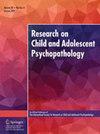关于将 Bifactor S-1 模型应用于 ADHD/ODD 症状多源评级的评论:症状评级的适当双因素模型。
IF 3.6
引用次数: 6
摘要
我的评论分为四个部分。首先,我总结了最初将对称双因素模型拟合到 ADHD 数据中的原因。其次,我总结了伯恩斯及其同事对 ADHD 项目级数据拟合对称双因子模型提出的担忧,并介绍了他们推荐的替代方法。第三,我提出了我对他们手稿的两个疑虑。第四,最后我就继续研究 ADHD 症状的因子结构的优点提出一个警告和一般性问题。本文章由计算机程序翻译,如有差异,请以英文原文为准。
Commentary on Application of the Bifactor S-1 Model to Multisource Ratings of ADHD/ODD Symptoms: An Appropriate Bifactor Model for Symptom Ratings.
My commentary is organized into four sections. First, I summarize the reasons for the original interest in fitting symmetric bifactor models to ADHD data. Second, I summarize the concerns that Burns and colleagues raised with respect to fitting symmetric bifactor models to ADHD item-level data and describe their recommended alternative approach. Third, I raise two concerns that I had with their manuscript. Fourth, I conclude with a caveat and a general question about the merits of the continued study of the factor structure of ADHD symptoms.
求助全文
通过发布文献求助,成功后即可免费获取论文全文。
去求助
来源期刊

Journal of Abnormal Child Psychology
Multiple-
自引率
0.00%
发文量
0
期刊介绍:
Research on Child and Adolescent Psychopathology brings together the latest innovative research that advances knowledge of psychopathology from infancy through adolescence. The journal publishes studies that have a strong theoretical framework and use a diversity of methods, with an emphasis on empirical studies of the major forms of psychopathology found in childhood disorders (e.g., disruptive behavior disorders, depression, anxiety, and autism spectrum disorder). Studies focus on the epidemiology, etiology, assessment, treatment, prognosis, and developmental course of these forms of psychopathology. Studies highlighting risk and protective factors; the ecology and correlates of children''s emotional, social, and behavior problems; and advances in prevention and treatment are featured.
Research on Child and Adolescent Psychopathology is the official journal of the International Society for Research in Child and Adolescent Psychopathology (ISRCAP), a multidisciplinary scientific society.
 求助内容:
求助内容: 应助结果提醒方式:
应助结果提醒方式:


